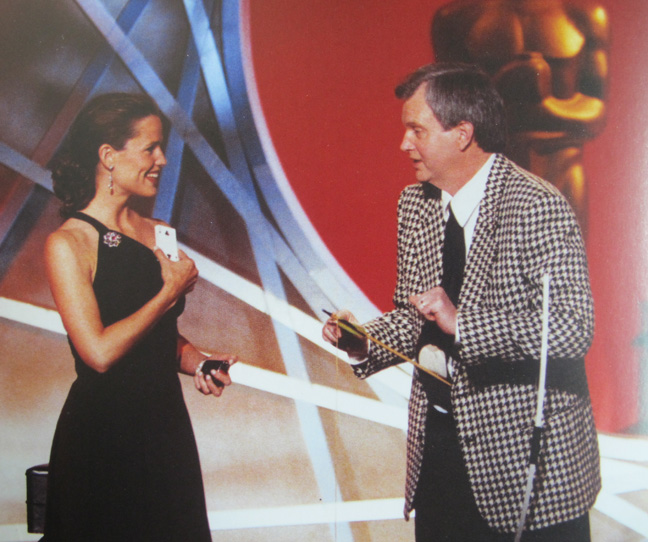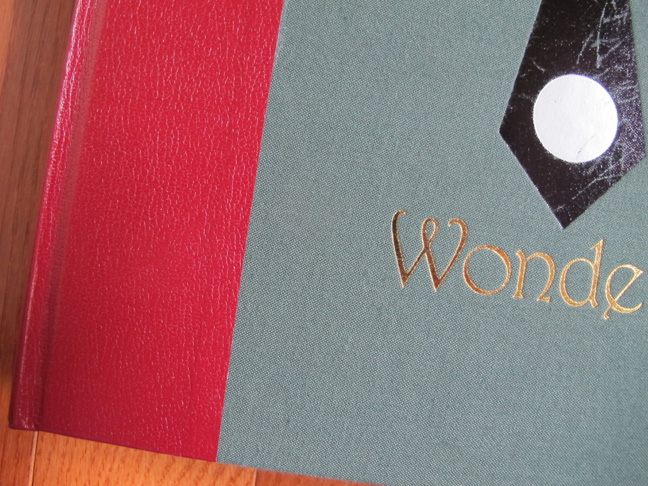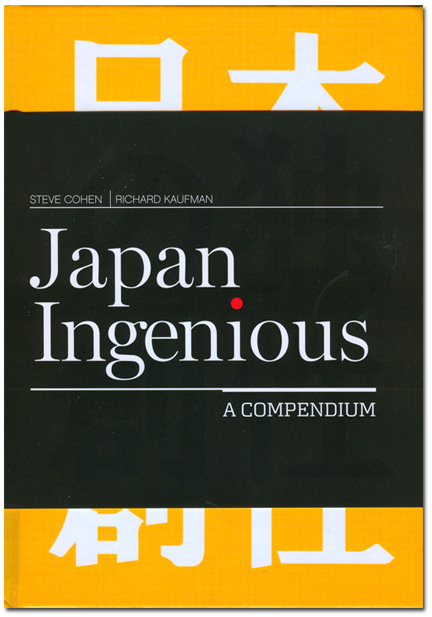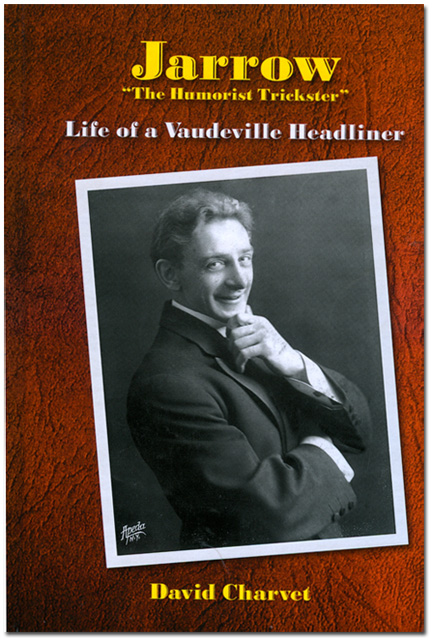
|
Note ye ed's email address: stevebryant99@gmail.com. |


Books of wonder.
|
|
August 2013 It was a tradeoff: either attend MAGIC Live 2013, or stay home an witness the birth of a grandchild. I chose the latter, and welcome to the world, Charlie Beverton. (Charlie was named for a famous Irish soccer player, Charlie O'Hagan; you can google him.) Meanwhile, I understand that Stan's latest outing was terrific, and I was able to experience what I could of it in two ways: First, Scott Wells posted daily podcasts, which you can find via iTunes or via Scott's web site, The Magic Word. (Also recommended: day 4 of the IBM convention podcast has a hilarious Walter Blaney-David Hoy story.) Thanks, Scott. Second, much of what I would have purchased from the dealers I purchased online and have already received the new Mike Caveney books, the new Richard Kaufman-Steve Cohen Japan Ingenious, and David Charvet's Jarrow. The Gaeton Bloom books and the John Bannon books are on order but didn't arrive yet. Not bad residue from a convention I didn't even attend. Congratulations to Joshua Jay for completing his twelve-year run as MAGIC's trick editor. It's been a superb job. And congratulations to Caleb Wiles on your second trick in your new Genii column, "Ringside." For any who haven't caught on yet, Caleb is one of the most original modern thinkers in card magic who, like Mike Caveney, never considers a trick to be finished. And for now, we'll turn our attention to the books that did arrive and save the others for another month. What a nice summer for magic. |
|
|
Reviewer note: As everyone knows, Mike Caveney's amazing release this month is a two-volume book set. Wonders is his 456-page account of Mike's life as a creator and performer in magic. The Conference Illusions is his 256-page account of the illusions he has resurrected for the Los Angeles Conference on Magic History. (In addition to being one of magic's top performers, Mike is one of its top collectors and historians.) Because I am under incredible pressure to be working on things other than magic this month, I am going to limit most of my comments below to Wonders. This is not meant as a slight to The Conference Illusions. I've skimmed it and it is just as great. Indeed, should I ever get to perform anything from these books, I am most likely to begin with something I loved from the second book. But on to Wonders ... WONDER-FUL -- There are so many great tricks in Wonders that it's going to take a while to learn Mike Caveney's entire act! I've already dog-eared half a dozen pages ... No, no, no! Only an idiot would think like that. First, even though the book is about one guy's lifetime quest to be an idiot on stage, no one else can ever be Mike Caveney or Mac King or Tom Mullica or any other world class magician you can name. Second, no one is going to dog-ear any pages in books of this magnificence. This is the finest set of books I have ever owned. This is the finest thing in magic that I have ever owned. More on that later. Mike Caveney is one of those fortunate individuals to have been in the right place at the right time in his youth, to have been part of and to have emerged from one of those special magical primordial soups that, like nebulae, became star nurseries across the twentieth century. There were others just as fertile: the cafeteria at 42nd Street and Sixth Avenue in New York, Chicago under Marlo's reign, Hollywood and the Magic Castle under Vernon's. While those three generated close-up stars and close-up magic, Mike was part of the Long Beach Mystics, a youth group that tended to generate stage stars and stage magic. Two other factors gave him triple-threat promise: in addition to their magic-crazy peers, the Mystics had mentors, namely Channing Pollock and Marvyn Roy; and Mike got his hands dirty in magic shops, in the manufacturing side of Owen Brothers and Johnson Products. All would heavily influence his thinking and talents. Later he would join a gang called the Left-Handed League, and they too would have an influence, and don't even get me started on how lucky he's been at love. Today, the Mystics are the walking-tall heroes of magic. You can almost hear the soundtrack to The Magnificent Seven in the background when they congregate.  Magic introduces you to the most interesting people. From its privileged beginnings, the Mike Caveney story takes off, and in 456 pages we get an entire lifetime (well, so far!) of magical evolution, from Mike's earliest teen magic (a great Substitution Barrel trick with Stan Allen that made no sense) to his current working repertoire (Coffee Juggling, Magic Paper, Bow & Arrow, and Scissors, Coat, Silverware & Chicken). As Mike puts it, "The purpose of this book is not to provide you with forty minutes of new material but rather to increase your magical knowledge and to demonstrate the long, slow process that is required to create new magic routines." A few things that impressed me along the journey: The best Invisible Deck routine I've ever read. Warning: you'll need 52 such decks. The story of how Albert Goshman smuggled sponge balls into Japan. The walk-off gag ending to The Linking Coat Hangers. The Lubor Die routine. The only other guy I've seen do this was Jay Marshall. Mike's routine was probably better because of all the extra thought that went into it. This was one of the first examples of how Mike worked hard to build props that were simply better than anything available elsewhere. The Halloween Card Stab. Mike used Tina as a table for the Malini Card Stab and inadvertently stabbed and killed her. I wish I had this back when I was doing regular Halloween shows. The Phome Book. A huge phone book is tossed into the audience to watch the spectators scatter. I've never stolen anything from Mike Caveney, but I came close on this one. I once retrieved a huge phone book from a dumpster and later filled it with a chunk of foam. I finally never performed it, but I came close. In my mind, it was all about the girl under the table. How Mike did the Card on Window on the Orient Express. Nind Reading (yes, I spelled that correctly) was a very funny two-person mind reading act that fooled the Magic Castle audience and staff badly thanks to an "invisible" third person. Spoiler Alert: Skip this one because I'm going reveal what should be a secret. The first trick I turned to on receiving the books was Coffee Juggling. This routine blows me away every time I see Mike do it. According to the book, there is no trick. It's just juggling! Mike says he tries to prove that it's juggling throughout the stunt. He pours cream in, he drops a sugar cube in, and so on. But in magic, that is backwards to me. If he is trying to prove that it is juggling, then I assume the opposite is true. We do the Twisting Move in the Linking Rings to prove that there is no hole. But there is a hole. So, is this a sneaky Left-Handed League gag to make us wham coffee cups off our ceilings as we try to really juggle (when there is really, say, a magnet holding the cup in place)? Or is it the truth, and we are going to wham cups off our ceilings anyway? Whatever, this is one of my all-time favorite routines in magic.  Let's see Anthony Gatto do this. One of the reasons many of you will not be doing some of Mike's signature effects is that they rely on specially machined contraptions, such as the Gatling Gun-like spoon-metal tray-water pitcher dispenser he uses in the Scissors, Coat, Silverware & Chicken trick. (Aside: if you've seen Mike dropping silverware from a spectator's coat, did you realize they were all spoons? Forks get hung up, and knives are too bulky.) The photos that chronicle the evolution of these gizmos look like a collection of steampunk art.  This steampunk doohickey holds 60 spoons, 2 trays, and a metal pitcher. Speaking of the chicken, Mike includes hilarious accounts of what it was like to travel with a live chicken, especially sneaking his feathery pal Smeddy past airport security. (Fellow Mystic Dana Daniels has similar stories about traveling with a parrot.) When traveling with a bird became just too awkward, Mike finally spent a whole lot of money to purchase a custom designed animatronic chicken, even though it looks more like "a time bomb" when X-rayed at security. A few nights ago, over dinner, I attempted to regale my zero-tolerance-for-magic bride Maleficent with stories of Mike's chicken travels, climaxing with the purchase of Robo Chick. She looked at me in disbelief and said coldly, "I've got an idea. Just do a different trick." No imagination!  Who ordered dinner? So much for the magic (to be fair, there is plenty in the book that you can perform, in case I've given the wrong impression); let's talk about the books themselves. I feel sorry for all those folks who bought their copies at MAGIC Live 2013, because they were going to be over the weight limit at the airport. These are two massive 9 by 11.5-inch books in a matching slipcase, the slipcase itself lined with a paper that looks like Mike's signature houndstooth jacket. The book covers appear to be leather and cloth, with three-color foil stamping. Quoting from the ads, the 456 pages are in full color on heavy art matte paper, with printed end sheets and a tipped-in color frontispiece (of Mike's poster; early purchasers got the real thing). Physically, they look, feel, and smell terrific. I'd like to invite neighbors over to just admire them.  These books exude quality. Inside, they are even better. A lifetime of producing magic books has given Mike a fine grounding on how to produce a perfect book. I was in tears just reading how good Mac King's Foreword was. Mike's writing is just as good. Reading these guys is like reading E.B. White or James Thurber. It has long been my contention that my friends and idols in magic, collectively and often individually, are smarter, more rounded folks than my other sets of friends, and my other sets include advanced degree engineers and college professors. This has surprised me, given that many of us began life as social misfits, but life and especially this set of books bear witness to the contention. (The second book has a Foreword by Jim Steinmeyer, so long as we are dropping genius names here.) The sensational side benefit to Mike's fine writing is that he writes pitch perfect patter. In a few brief sentences he establishes the premise (in his case, that an idiot is about to attempt the impossible) with none of the drek that infects so much patter in magic. (OK, not all magicians are brilliant. Some remained social misfits as they grew up.) The best example of this for me was in The Conference Illusions, citing Mike's patter for The Astral Hand. For years I have struggled with how to make a rapping hand (or talking skull or Grandma's dentures) communicate from the beyond via one rap for yes, two for no, in a way that isn't slow and boring. Mike has worked out a solution that is baffling, funny, and easy to code to your offstage assistant who is initiating the raps. Just perfect! The text is beautifully laid out, illustrated with hundreds of photos (570 for Wonders, 330 for The Conference Illusions), most by the indefatigable and excellent Bill Taylor, and sprinkled here and there (as were Tina's lecture notes) with wisdom from the likes of John Wooden, Steve Jobs, and R. Buckminster Fuller. Available from Mike Caveney's Magic Words, $240 plus $15 domestic postage. An absolute bargain and a must read. |
|
|
FROM THE FOLKS WHO BROUGHT YOU TENYO -- If for no other reason, Richard Kaufman is a great guy, so buying a copy of Japan Ingenious is a nice way to help him pay for all those trips he made to the Japanese hinterlands to put the book together. There are 65 other reasons, namely the great tricks that made it into the book. The book began as Winners, a collection of prize-winning magic from Japan (Steve Cohen translated these and those of subsequent winners), and it has been rounded out with Japanese magic that Max Maven and Richard Kaufman have described elsewhere. This is Richard Kaufman's fifth book of magic from Japan (and a surprise, given all the talk about the Deland and Tenyo books), and the one thing that is overwhelmingly obvious from reading all of them is how strikingly visual the magic is. I don't know if that is because the Japanese magicians specialize in visual magic or if it is just a matter of patter-heavy non-visual magic not getting translated. Whatever, this is fun stuff to witness.  More visual magic from Japan. Some of my favorites from Genii are here, including Hiro Skai's One-Man Self-Levitation (I recently saw this in a child's magic set!), Kenichi Kuroki's Sneaky Sneaker (the bow is transposed from the top of the laces to the bottom), and Dr. Sawa's Ping-Pong Pocus (the ball changes color twice and the paddle shrinks). There were some really interesting new Rising Card tricks, in which one card rises inside a lattice framework a la Copperfield's Elevator Illusion (thus called Hideki Tani's Elevator Illusion) and another in which a card rises thanks to some sawing with an impromptu card frame (Kuniyasu Fujiwara's Original Card Quake). Arnold Meetachick's Card Trick (Olson and Pearce's Sick Sorcery) was the first card trick I encountered whose premise was a ploy to meet a girl. Hiro Sakai provides several items to help you meet and win the girl over. Who knows? These might change your life. I love math-based self-working tricks and was therefore intrigued by Takanobu Ishida's Date/Time Cards and Kuniyasu Fujiwara's Automatic Ace Triumph. There is plenty more, including seven from Dr. Sawa. Among those, new to me was The Sleeve Shootout, a startling production of several jumbo coins. All this is handsomely packaged in 252-page hardback from Kaufman and Co., nicely illustrated by Ton Onosaka and Earl Oakes, with design and layout by Brad Aldridge. $40 until August 21, then $60. |
|
|
JUICED -- A couple of years ago in Chicago, at the last Chicago Magic Collectors Weekend, David Charvet gave a fascinating lecture on Jarrow, the still-famous vaudeville magician. As David pointed out, several things have happened since his 1990 The Bill in Lemon Book. First, Jarrow's grandson, Richard Townsend, turned up with more family photos and stories. Second, the internet exploded, making research easier than ever. And third, it was discovered that Jay Marshall had planned a book on Jarrow, and all his work came into David's hands via auction. Enough, it turned out, to warrant a new book, Jarrow. (You can take your pick of subtitles, because there is a different one on every title page, including "Life of a Vaudeville Headliner," "Life of a Vaudeville Magician," and "Creator of the Lemon Trick.")  Jarrow in an all-new edition. The book is divided into two sections, one on Jarrow's life, and one on his magic act. The life is truly fascinating, with his beginnings as a sideshow strong man and his evolution to a vaudeville stage performer who did only sleight of hand, climaxing with a challenge bill to lemon trick. As is well known in magic, when Goldin began drawing crowds with Sawing a Woman in Half, Jarrow drew them back with Jarrow--Sawing a Lemon in Half. Jarrow's Jacob's Ladder effect was in one of my earliest magic books, so I've been doing Jarrow material for over fifty years. It was a pleasure to finally read his entire story. Hardbound, 168 pages, $40 plus $5 shipping from David Charvet Studios (charvetmagic.com). |
 The first time I saw his name.
Welcome, Charlie.
Little Egypt Magic is the erratically updated web site of Steve Bryant, spawned (the site, not Steve) by a former internet magazine known as The Little Egypt Gazette/for magicians only. Steve Bryant is an obscure magician and writer who generates this site from an iMac in Bloomington, Indiana. He used to frequently journey to and perform magic in Little Egypt, the local name for extreme southern Illinois, where the towns bear such names as Cairo, Thebes, and Karnak. Past issues of this web site: Index to Past Issues Notice: Any limited use of copyrighted images or quoted text is considered fair use, usually to review whatever product or event that is under discussion. If you object to use of any material, please get in touch and it will be cheerfully removed. |
A JSB Creations product
Copyright© 2013 by Steve Bryant